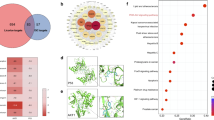Summary
The role of heat shock protein 70 (HSP70) in apoptosis of human retinal pigment epithelial cells (ARPE-19) induced by 4-hydroxy-2-nonenal (4-HNE) was explored. Different concentrations of 4-HNE were used to stimulate ARPE-19 cells, and apoptosis was measured by flow cytometry. The expression of apoptotic-related proteins, HSP70, X-linked inhibitor-of-apoptosis (XIAP), Bcl-2, and Bax were quantified by Western blotting. HSP70 and XIAP overexpression plasmids, or their corresponding siRNAs were transfected into ARPE-19 cells using Lipofectamine™ 2000. Co-immunoprecipitation and Western blotting were used to detect the effect of 4-HNE on the expression of HSP70 and the binding level between 4-HNE and HSP70. The results showed that 4-HNE induced late apoptosis in ARPE-19 cells, accompanied by elevated levels of 4-HNE-modified HSP70, but it did not affect HSP70 protein expression. 4-HNE-modified HSP70 down-regulated the expression of the apoptosis inhibitory protein XIAP. Overexpression of HSP70 or XIAP inhibited 4-HNE-induced apoptosis of ARPE-19 cells. It was suggested that 4-HNE could promote XIAP degradation by modification of HSP70 to induce late apoptosis of human retinal pigment epithelial cells.
Similar content being viewed by others
References
Jin M, Dai H, Zhang X, et al. A Traditional Chinese Patent Medicine ZQMT for Neovascular Age-Related Macular Degeneration: a multicenter randomized clinical trial. Curr Mol Med, 2018,18(9):622–629
Cheng Z, Yao W, Zheng J, et al. A derivative of betulinic acid protects human retinal pigment epithelial (RPE) cells from cobalt chloride-induced acute hypoxic stress. Exp Eye Res, 2018,180:92–101
Dieguez HH, Romeo HE, Alaimo A, et al. Oxidative stress damage circumscribed to the central temporal retinal pigment epithelium in early experimental non-exudative age-related macular degeneration. Free Radic Biol Med, 2018,131:72–80
Czerwinska J, Poznanski J, Debski J, et al. Catalytic activities of Werner protein are affected by adduction with 4-hydroxy-2-nonenal. Nucleic Acids Res, 2014,42(17):11119–11135
Castro JP, Jung T, Grune T, et al. 4-Hydroxynonenal (HNE) modified proteins in metabolic diseases. Free Radic Biol Med, 2017,111:309–315
Baek JH, Lim D, Park KH, et al. Quantitative proteomic analysis of aqueous humor from patients with drusen and reticular pseudodrusen in age-related macular degeneration. BMC Ophthalmol, 2018,18(1):289
Ethen CM, Reilly C, Feng X, et al. Age-related macular degeneration and retinal protein modification by 4-hydroxy-2-nonenal. Invest Ophthalmol Vis Sci, 2007,48(8):3469–3479
Reeg S, Jung T, Castro JP, et al. The molecular chaperone Hsp70 promotes the proteolytic removal of oxidatively damaged proteins by the proteasome. Free Radic Biol Med, 2016,99:153–166
Li X, Yu Y, Gorshkov B, et al. Hsp70 Suppresses Mitochondrial Reactive Oxygen Species and Preserves Pulmonary Microvascular Barrier Integrity Following Exposure to Bacterial Toxins. Front Immunol, 2018,9:1309
Chen J, Wang L, Chen Y, et al. Phosphatidylinositol 3 kinase pathway and 4-hydroxy-2-nonenal-induced oxidative injury in the RPE. Invest Ophthalmol Vis Sci, 2009,50(2):936–942
Cesa LC, Shao H, Srinivasan SR, et al. X-linked inhibitor of apoptosis protein (XIAP) is a client of heat shock protein 70 (Hsp70) and a biomarker of its inhibition. J Biol Chem, 2018,293(7):2370–2380
Van Lookeren Campagne M, LeCouter J, Yaspan BL, et al. Mechanisms of age-related macular degeneration and therapeutic opportunities. J Pathol, 2014,232(2):151–164
Nguyen CL, Gillies MC, Nguyen V, et al. Characterisation of poor visual outcomes of neovascular age-related macular degeneration treated with anti-vascular endothelial growth factor agents. Ophthalmology, 2019, 126(5):735–742
Totsuka K, Ueta T, Uchida T, et al. Oxidative stress induces ferroptotic cell death in retinal pigment epithelial cells. Exp Eye Res, 2019,181:316–324
Bellezza I. Oxidative Stress in Age-Related Macular Degeneration: Nrf2 as Therapeutic Target. Front Pharmacol, 2018,9:1280
Hytti M, Piippo N, Salminen A, et al. Quercetin alleviates 4-hydroxynonenal-induced cytotoxicity and inflammation in ARPE-19 cells. Exp Eye Res, 2015,132:208–215
Sugano E, Murayama N, Takahashi M, et al. Essential role of thioredoxin 2 in mitigating oxidative stress in retinal epithelial cells. J Ophthalmol, 2013,2013:185
Masuda T, Shimazawa M, Takata S, et al. Edaravone is a free radical scavenger that protects against laser-induced choroidal neovascularization in mice and common marmosets. Exp Eye Res, 2016,146:196–205
Subrizi A, Toropainen E, Ramsay E, et al. Oxidative stress protection by exogenous delivery of rhHsp70 chaperone to the retinal pigment epithelium (RPE), a possible therapeutic strategy against RPE degeneration. Pharm Res, 2015,32(1):211–221
Carbone DL, Doorn JA, Kiebler Z, et al. Inhibition of Hsp72-mediated protein refolding by 4-hydroxy-2- nonenal. Chem Res Toxicol, 2004,17(11):1459–1467
Gao C, Yu H, Yan C, et al. X-linked inhibitor of apoptosis inhibits apoptosis and preserves the blood-brain barrier after experimental subarachnoid hemorrhage. Sci Rep, 2017,7:44 918
Kirkegaard T, Gray J, Priestman DA, et al. Heat shock protein-based therapy as a potential candidate for treating the sphingolipidoses. Sci Transl Med, 2016,8(355):355ra118
Author information
Authors and Affiliations
Corresponding author
Additional information
This project was supported by grants from the Natural Science Foundation of Hubei Province, China (No. 2009CDB115, and No. 2012FKB02444), and Natural Science Foundation of Health and Family Planning Commission of Wuhan Municipality (No. WX18Q03, and No. WX18Q27).
Rights and permissions
About this article
Cite this article
Yang, Ll., Chen, H., Wang, J. et al. 4-HNE Induces Apoptosis of Human Retinal Pigment Epithelial Cells by Modifying HSP70. CURR MED SCI 39, 442–448 (2019). https://doi.org/10.1007/s11596-019-2057-8
Received:
Revised:
Published:
Issue Date:
DOI: https://doi.org/10.1007/s11596-019-2057-8




